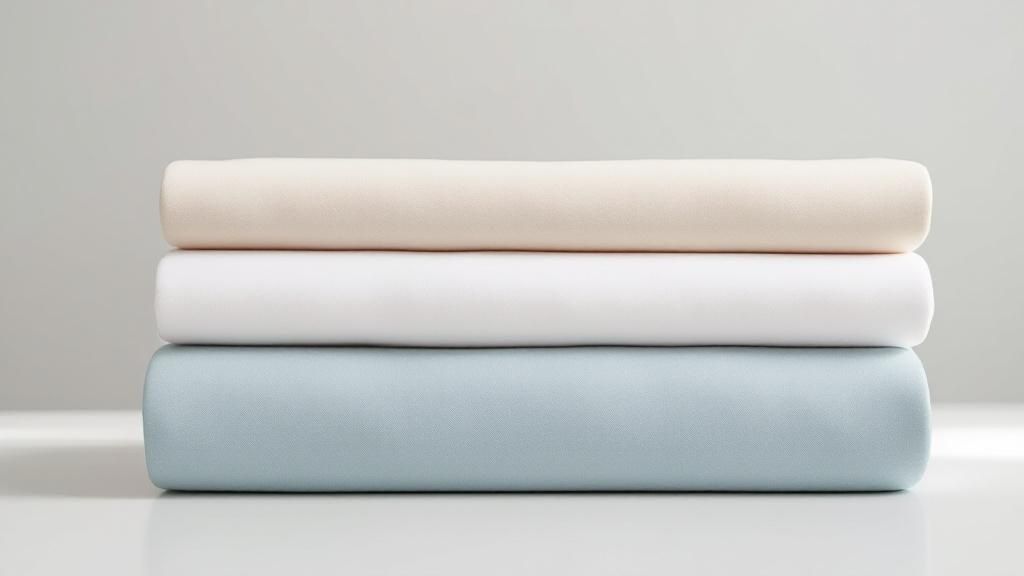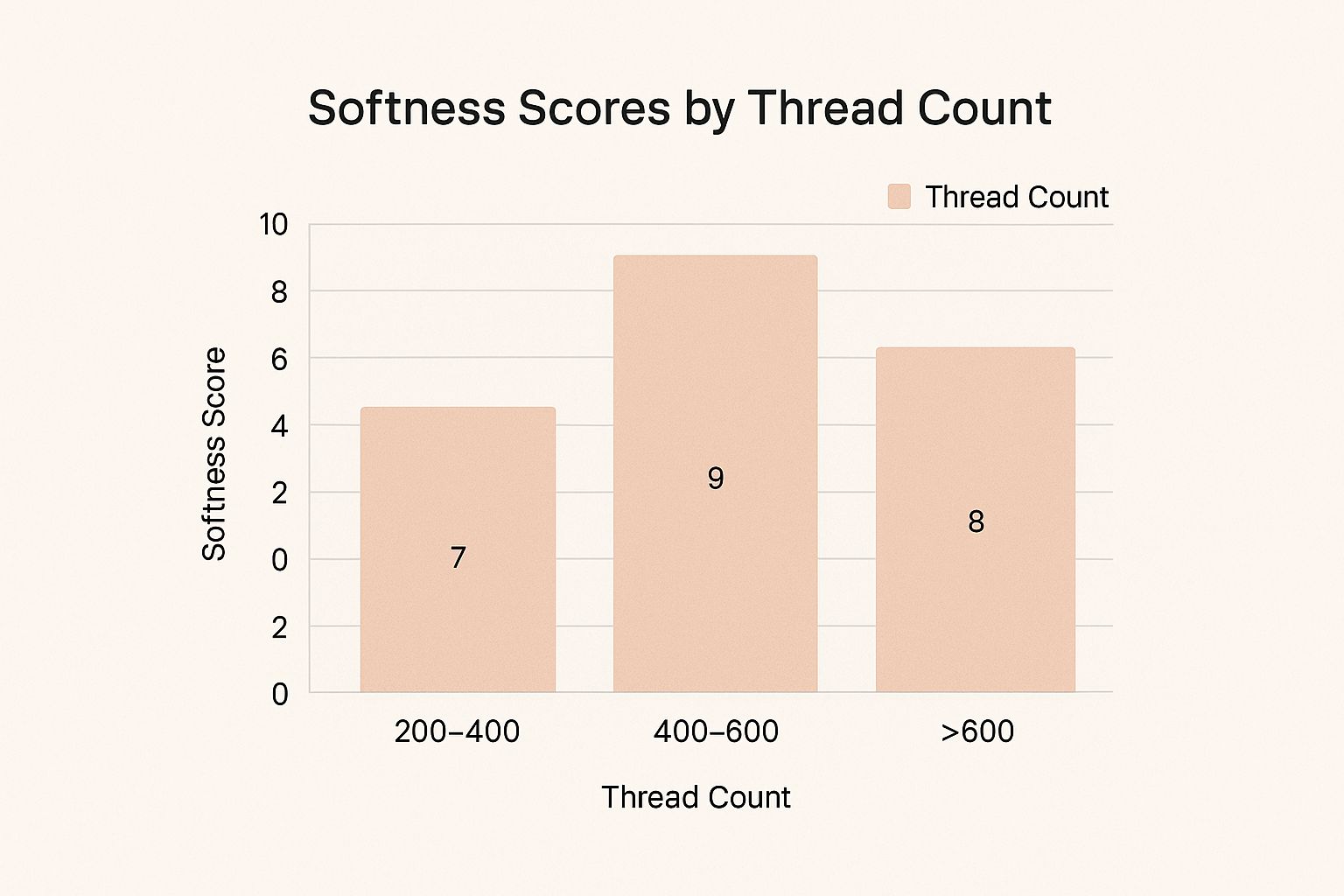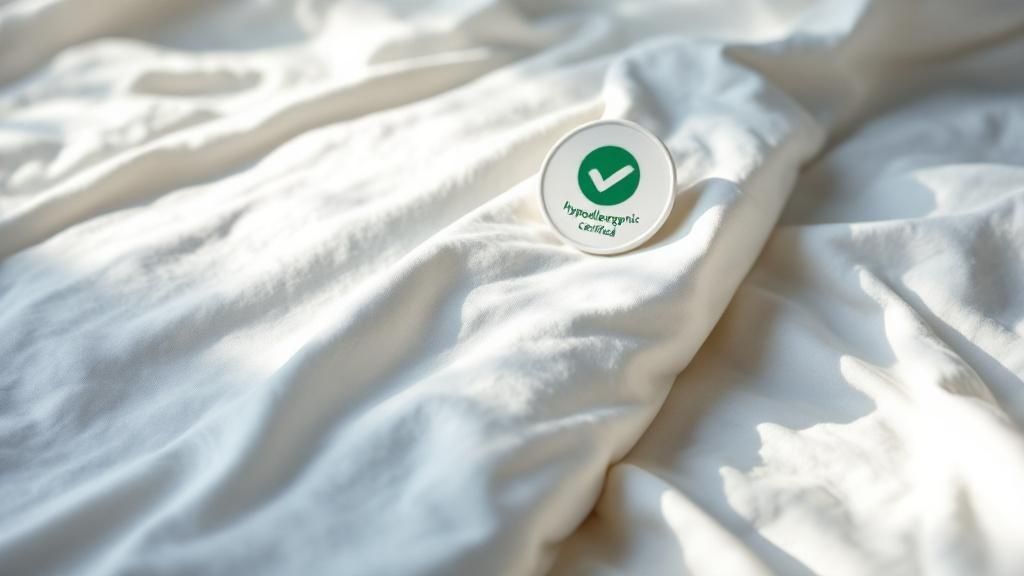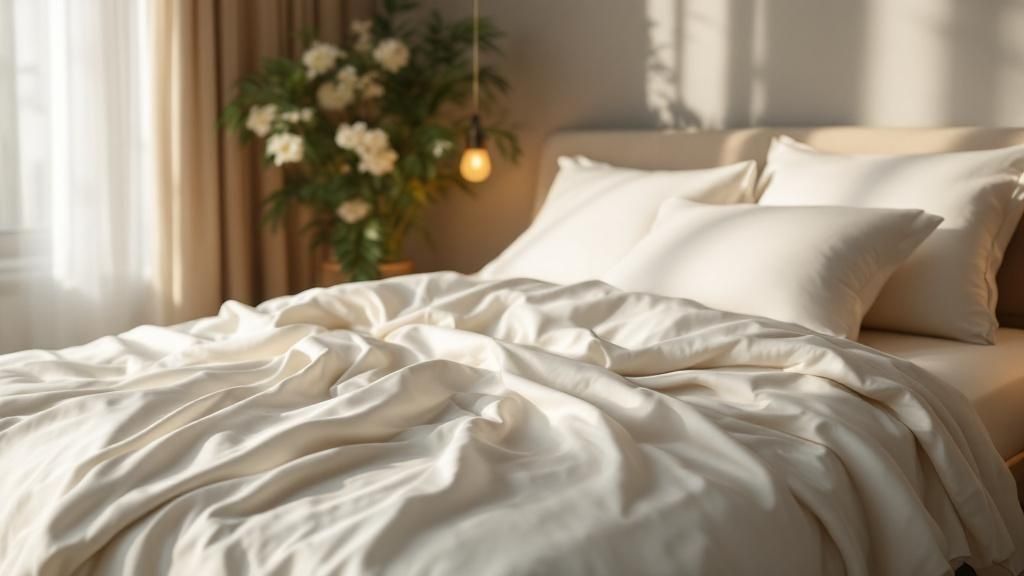If you've ever woken up with mysterious redness or irritation, your bedsheets might be the secret offender. For those of us with sensitive skin, the right sheets are more than just a comfort—they're a necessity. The best sheets for sensitive skin are almost always made from 100% organic, breathable, and naturally hypoallergenic materials like bamboo, high-quality cotton, or linen. These fabrics are known for soothing the skin, not aggravating it.
Why Your Bedding Might Be Betraying Your Skin

It’s easy to blame a new skincare product or diet when your skin acts up. We often overlook the one thing we spend a third of our lives touching: our bedding. But for the eight hours you spend in bed, your sheets can either calm your skin or contribute to flare-ups of conditions like eczema, rosacea, and general sensitivity.
The problem usually boils down to three things: the fabric, its texture, and the chemical treatments used to make it. Synthetic fabrics like polyester, for example, are notorious for trapping heat and moisture. This creates a warm, humid environment against your skin—the perfect breeding ground for bacteria and clogged pores.
Common Culprits Hiding in Your Sheets
Even natural fibers aren't automatically in the clear. A low-quality cotton with a coarse, rough weave can create constant micro-friction against your skin all night. This physical rubbing can lead to redness, inflammation, and a compromised skin barrier. It’s a perfect example of why the feel and texture of a fabric are just as crucial as the material itself.
And then there are the chemicals. To get those "wrinkle-free" or vibrant color claims, many manufacturers treat fabrics with harsh dyes and finishing agents, including formaldehyde. These residues don't just wash out; they can seep into your skin while you sleep, triggering allergic reactions and contact dermatitis.
Here’s a quick breakdown of what might be going wrong:
- Trapped Heat: Synthetic materials like polyester don't breathe. This leads to night sweats, which can clog pores and fuel irritation.
- Abrasive Textures: Rough weaves or low-quality cotton can physically chafe and disturb your skin's protective barrier.
- Chemical Residues: Formaldehyde, harsh dyes, and other finishing agents are common triggers for rashes and skin sensitivity.
The good news? Sometimes, the most impactful change is also the simplest. Switching your bedding can bring dramatic improvements not just to your skin, but to your overall sleep quality, too.
This shift toward healthier materials isn't just a niche trend. The global organic bedding market was valued at USD 531.3 million in 2024 and is projected to nearly double by 2033. You can read more about the organic bedding market growth on imarcgroup.com. It's clear people are waking up to the fact that what we sleep on directly affects our well-being.
Choosing the Right Fabric for Calm, Comfortable Skin
When you're dealing with sensitive skin, the material touching you for eight hours a night becomes a critical choice. The right fabric does more than just feel nice; it should actively create a soothing environment that prevents irritation, manages moisture, and allows your skin to breathe.
Let's walk through the best contenders I've come across for sensitive skin and what makes each one special.
Organic Cotton: The Pure and Simple Choice
Organic cotton is often the first stop for anyone seeking skin-friendly bedding, and for good reason. It's grown without the pesticides or harsh chemicals used in conventional cotton farming, which means fewer potential irritants ever make it into the final product.
Its naturally long, smooth fibers create a soft weave that won't chafe or aggravate delicate skin. Plus, its breathability is a huge win. Air circulates freely, wicking away sweat and preventing the damp, humid environment where allergens and bacteria love to grow. It's an excellent all-around option for pure, simple comfort.
Linen: The Moisture-Wicking Powerhouse
If you need a real workhorse for your bed, look no further than linen. It's naturally hypoallergenic and antimicrobial, which immediately helps create a healthier sleep space. But its standout feature is its incredible ability to absorb moisture—it can hold up to 20% of its weight in water before it even starts to feel damp.
This moisture-wicking power keeps your skin dry and cool all night, cutting down the risk of rashes and irritation. While new linen can feel a bit crisp at first, don't let that deter you. It becomes exceptionally soft and supple with every wash, rewarding your patience with years of comfort.
A common misconception I hear is that a higher thread count always means softer, better sheets. For sensitive skin, breathability is often far more important than density. A super-high thread count can sometimes trap heat and reduce airflow, which is the last thing you want.
When it comes to softness, there's a definite sweet spot. This chart shows how softness scores often peak in the mid-range thread counts.

As you can see, the 400-600 thread count range often delivers that perfect balance of softness and comfort without sacrificing breathability.
Bamboo and Silk: The Ultra-Smooth Options
For a truly luxurious, silky feel, bamboo and silk are in a class of their own. Fabrics made from 100% organic bamboo sources offer a uniquely smooth surface that just glides over the skin with minimal friction. This is a game-changer for preventing the mechanical irritation that can trigger conditions like eczema. We cover the many reasons why bamboo sheets are a superior choice in our detailed guide.
Silk is another fantastic option because of its extremely low-friction texture. It's famously gentle on both skin and hair and helps prevent those morning sleep creases. Like bamboo, it's naturally hypoallergenic and a great temperature regulator.
Comparing the Best Sheet Fabrics for Sensitive Skin
To make things easier, here’s a quick-glance comparison of the top recommended fabrics. This table helps weigh the pros and cons based on the key attributes that matter most for skin comfort.
| Fabric Type | Key Benefit for Skin | Feel & Texture | Breathability | Best For |
|---|---|---|---|---|
| Organic Cotton | Hypoallergenic, no chemical residues | Soft, crisp, and gets softer over time | High | All-around purity and classic comfort |
| Linen | Highly absorbent and antimicrobial | Initially crisp, becomes very soft | Excellent | Hot sleepers and humid climates |
| Bamboo | Extremely low-friction, silky smooth | Buttery soft, drapes well | Very high | Preventing irritation from friction (e.g., eczema) |
| Silk | Ultra-smooth surface, prevents creases | The smoothest, most luxurious feel | Moderate | Ultimate gentleness on skin and hair |
Ultimately, choosing the best fabric comes down to balancing your personal preferences for texture with your skin's specific needs. Whether it's the pure feel of cotton, the cool touch of linen, or the slick glide of bamboo, the right sheets can make a world of difference.
How to Read Labels and Certifications Like a Pro

Walking down the bedding aisle can feel like trying to crack a secret code. You're bombarded with buzzwords and lofty claims, but how can you tell which sheets are genuinely safe for your skin? The trick is to look right past the marketing fluff and focus on the third-party certifications.
Think of these labels as your reliable guide. They're independent proof that the sheets you’re considering are free from the hidden irritants that can cause so much trouble for sensitive skin. Honestly, learning what these certifications mean is the best tool you have for buying with confidence.
Key Certifications to Look For
When you're specifically shopping for the best sheets for sensitive skin, two labels really stand out: OEKO-TEX and GOTS. These aren't just decorative logos; they signify that the product has passed some seriously strict testing.
-
STANDARD 100 by OEKO-TEX: This is probably the most important certification to find. It guarantees that every single part of the product—from the fabric and thread right down to the buttons—has been tested for a long list of harmful substances and found to be clean. Seeing this label is a solid assurance that the material is safe to have against your skin all night.
-
Global Organic Textile Standard (GOTS): This one takes things a step further. GOTS certification doesn't just check the final product for harmful chemicals; it verifies that the entire production chain is organic. That means the cotton or linen was grown without pesticides and processed without toxic dyes or harsh chemical finishes.
A quick tip: You'll see the word 'hypoallergenic' everywhere. While it sounds good, the term isn't regulated. A certification like OEKO-TEX, on the other hand, provides verifiable proof that the sheets are free from a wide range of known allergens and skin irritants.
The demand for this kind of transparency is making waves. The organic bedding market was already valued at around USD 936.4 million in 2023, and it's expected to keep climbing as more of us look for chemical-free homes. You can dig into the numbers and see how this trend impacts consumer choices at Grand View Research.
This shift shows that people are tired of guessing. By learning to spot these key certifications, you can cut through the noise and choose bedding that actually supports your skin's health.
Watch Out for These Red Flags When Buying Bedding
It’s one thing to know what you should look for in new sheets, but it's just as important to recognize what you should run from. When you have sensitive skin, certain materials and marketing buzzwords are dead giveaways for bedding that will only lead to itchiness, irritation, and a bad night's sleep.
The biggest culprits are almost always synthetic fabrics. Materials like polyester and acrylic are basically forms of plastic. They don't breathe. Instead, they trap heat and moisture right next to your skin, turning your bed into a warm, damp environment where bacteria and dust mites can have a field day. For anyone with reactive skin, that's a nightmare waiting to happen.
Don't Be Fooled by Misleading Labels and Hidden Chemicals
I see this all the time: a set of sheets marketed as “wrinkle-free” or “easy care.” It sounds great, but that convenience usually comes at a cost. To get that smooth, no-iron finish, manufacturers often treat the fabric with a formaldehyde resin. Even though the levels are low, trace amounts are more than enough to trigger contact dermatitis and other allergic reactions in sensitive individuals.
You should also be skeptical of intensely bright or dark-colored sheets that don't have an OEKO-TEX certification. Achieving those vibrant colors often requires harsh dyes loaded with heavy metals. If not washed out properly, these residues stay in the fibers and can leach onto your skin, causing irritation over time.
Here's a common myth I want to bust: an extremely high thread count (think over 800) doesn't automatically mean better quality. In reality, a weave that dense can actually trap air and feel heavy, making the fabric less breathable—the exact opposite of what you need to keep sensitive skin cool and calm.
To protect your skin and ensure a comfortable rest, here are the main things to steer clear of:
- Purely Synthetic Fabrics: Say no to 100% polyester, microfiber (which is just a fancy name for polyester), and acrylic.
- "Wrinkle-Free" Promises: This is a common red flag for chemical treatments that can aggravate the skin.
- Uncertified Bright Dyes: Your best bet is to choose natural, undyed options or look for that explicit OEKO-TEX label.
- Over-the-Top Thread Counts: Forget the marketing hype. A thread count between 300-500 in a high-quality material like cotton or bamboo offers the perfect balance of softness and breathability.
A Gentle Care Routine for Your New Sheets
So, you've invested in the perfect sheets. Now, let's talk about keeping them that way. The right care routine is what will protect the soft, hypoallergenic feel of your new bedding, making sure it remains a sanctuary for your sensitive skin. Honestly, it's not about a lot of hard work—it’s just about creating a few smart habits.
The first place to start is with your laundry detergent. I always tell people to reach for a fragrance-free, dye-free, and hypoallergenic formula. It’s surprising how many mainstream detergents are packed with harsh chemicals and artificial scents that cling to fabrics, becoming a major source of skin irritation long after the wash is done.
Washing and Drying for Lasting Softness
When laundry day rolls around, stick with cold or warm water on a gentle cycle. I know it's tempting to use hot water to zap dust mites, but it can be really tough on delicate natural fibers like bamboo or organic cotton. Over time, that high heat will just break them down. A gentle wash in cooler water gets the job done without causing unnecessary wear and tear.
Here's a tip I've learned from experience: skip the fabric softener and dryer sheets. These products coat your sheets with a waxy, chemical film. It might make them feel soft for a moment, but that residue clogs the fabric's pores, kills breathability, and can transfer irritants straight to your skin.
When it comes to drying, low heat is the way to go. Tumble dry on a low setting or, if you have the space, line-dry them. High heat is the enemy of soft, durable fibers. Following these simple guidelines will make sure your investment in sheets for sensitive skin truly pays off with comfort that lasts.
For more in-depth advice, you can find our complete guide on how to care for your bamboo sheets.
Answering Your Top Questions About Skin-Friendly Sheets

Even after narrowing down the options, you might still have a few lingering questions. That's completely normal. Let’s clear up some of the most common queries I hear from people looking for sheets that won't irritate their skin. Getting these last details sorted will help you make a choice you feel great about.
A question that comes up all the time is how often you should be washing your sheets. If your skin is sensitive or prone to breakouts, the answer is simple: wash them once a week. This isn't just about hygiene; it’s about preventing the buildup of oils, sweat, and allergens that can easily trigger irritation while you sleep.
Does a Higher Thread Count Mean Better Sheets?
People often assume that the higher the thread count, the more luxurious and skin-friendly the sheet. But in my experience, that’s a myth, especially when it comes to sensitive skin. An incredibly high thread count (think over 800) can create such a dense weave that the fabric loses its breathability. This traps heat and moisture against your skin—a perfect recipe for irritation.
I've found that the sweet spot is a thread count between 300 and 500, especially in quality materials like organic bamboo or long-staple cotton. This range offers that perfect blend of silky softness and essential airflow, keeping your skin cool and calm all night long.
Another thing to think about is the color of your sheets. Those vibrant, dark-hued fabrics? They often require more intensive chemical dyes to achieve their rich colors. For some people, these dye residues can be a major source of skin reactions.
That's why sticking to white, off-white, or other naturally colored sheets is usually the safest route. Look for labels that say "undyed" or mention the use of low-impact, plant-based dyes. This little detail ensures fewer potential irritants are coming into contact with your skin. Plus, some fabrics offer their own cleanliness perks; you can read more about the antibacterial benefits of bamboo sheets on our blog.










